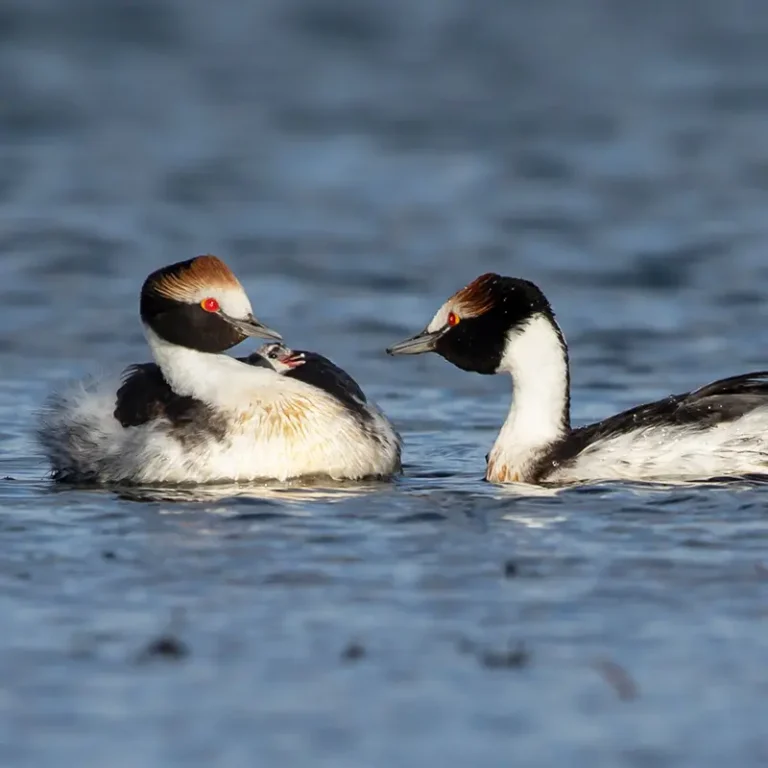Context and objectives
The Hooded Grebe Project emerged between 2009 and 2010 as an urgent conservation response to the marked population reduction detected in the species. From 2010, with the incorporation of researchers from CONICET and the Laboratory of Ecology and Animal Behavior (Faculty of Exact and Natural Sciences, University of Buenos Aires), we began to generate key information about its behavior, reproductive biology, genetic structure and, mainly, about the impact of the main threats it faces.
The results of these investigations provided the first tools that, already in 2011, allowed us to initiate conservation and direct management actions on the Hooded Grebes populations. The first step was the creation of the “Colony Guardians” program, aimed at maximizing the survival of nests—by protecting them from the impact of the Kelp Gull—and reducing the predation of adults and juveniles by the American mink.
In those early years, the project began to incorporate researchers from other CONICET institutes, such as CADIC (Ushuaia) and IPEEC-CENPAT (Puerto Madryn), in order to address the problems in a more comprehensive manner. This collaborative work made possible the design of the American mink control plans and the rainbow trout management plan, aimed at restoring key lagoons.
In parallel, the Hooded Grebe Project was adding the support of numerous national institutions, both governmental and private, as well as international organizations. Since then, the project has maintained uninterrupted conservation and research actions. Its main achievements include the reduction of the impact of the most relevant threats and the creation of protected areas dedicated to the conservation of this critically endangered species.
Our actions
- Protection of each colony detected each season through the technical team with the “Colony Guardians.”
- Control of problem individuals of Kelp Gull and management of the populations of this neonative species of the plateaus.
- Restoration of important lagoons on the Strobel plateau through the removal of Rainbow Trout.
- Control of the impact of the American Mink on the Hooded Grebe populations.
- Annual population censuses on all high plateaus and wintering sites (estuaries and large lakes).
- Installation of windbreaks and artificial platforms for nesting.
- Research on the ecology and behavior of the species, including reproductive biology and migration/movements.
- Research on the environment where it lives.
- Studies of the communities that accompany the Hooded Grebe.
- Volunteer and technical staff training, capacity building and capacity transfer.
- Ex situ rearing of ecologically lost eggs and release of captive-bred juveniles into the wild.
Protagonists
Habitat and behavior
It inhabits lagoons on the basaltic highlands of western Santa Cruz and during the winter, when these freeze, it migrates to the Atlantic coast, remaining in the estuaries of the Gallegos, Coyle, and Chico-Santa Cruz Rivers.
Feeding
It feeds on aquatic invertebrates, including arthropods, snails, water beetles, etc., and fish in the winter.
Reproduction
They build their floating nest in the high altitude lagoons, for which they use Vinagrilla (Myriophyllum quitense). It is built by both and then the female lays two eggs, from which she mostly raises only one chick. These birds perform a spectacular courtship to the eye, since their colors and movements are very striking and if we also remain silent, we will hear their unmistakable song.
Curiosity
The Hooded Grebe, currently with c. 800 individuals, is among the seven species included in the Zero Extinction Plan within the framework of the National Biodiversity Strategy and Action Plan 2016-2020 (Resolution MAyDS N°151/2017).
Threats
The main threats to the Hooded Grebe are invasive species (American Mink, Rainbow Trout, and Kelp Gull), infrastructure works (public lighting, electrical wiring, dams on the Santa Cruz River), and global climate change.

















